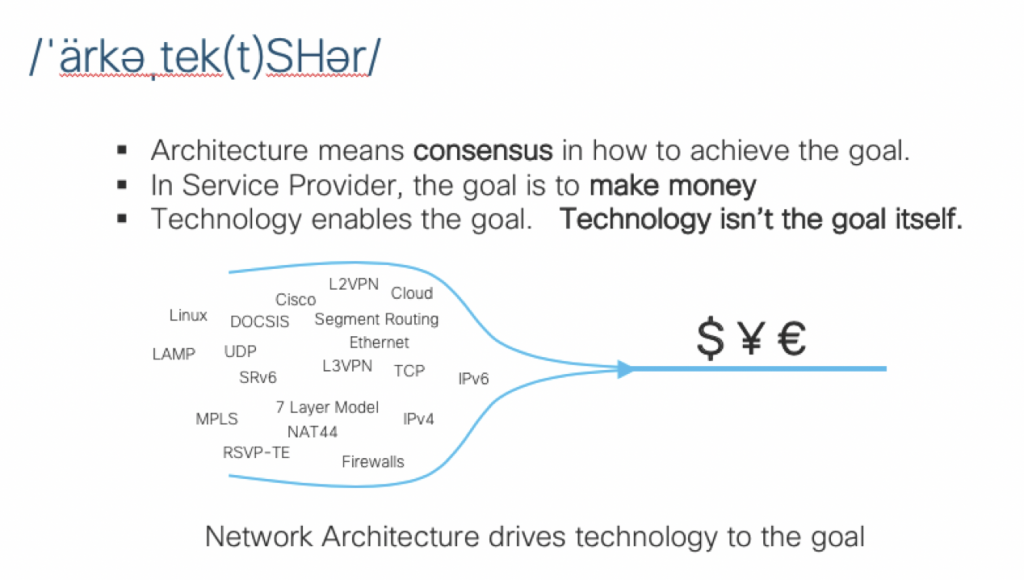With remote work and distance learning creating a surge in network usage, one would think the network might fail. But it hasn’t. Why? Because architecture experts are continuously planning and building out ways to anticipate the unanticipated. And, build network architecture that can stand up to any traffic test. This blog will re-visit a few basic principles and define concepts that ensure the network is always performing.
At its basic level, the architecture communicates what the network is supposed to do. The goal is to deploy network technology that has the flexibility to adjust to what people need when they need it. And, to do this in a way where new services can be added, capacity increased and managed based on changes and never, never fail. Why do networks not fail? In addition to good architecture, packet networking is connectionless, so a new path is signaled to take the traffic where it needs to go. Internet traffic is uncertain so packet networks work best in these uncertain times. Service provider network architect investments in packet technology are why the network did not collapse with the unprecedented capacity bursts.
Architecture means Consensus
In the networking industry, the role of ‘architect’ can have different meanings depending upon the context. Typically, an architect or architecture teamwork on the network design. Network architects have to be able to communicate and interconnect requirements in how the network is ultimately to function and drive the technology to the goal. These specialists need to understand what the network can do and map that understanding to deliver what subscribers want. They need to have a long-range forward-looking view, for they will be living with technology decisions for 20 to 30 years. Thru consensus teams find a way to make these networks, better, faster, more reliable. For example, coaxial cable networks were top of an architecture team’s mind 30 years ago. And, were deployed over 20 years ago in cable operators the last mile of operations to deliver broadband services. Over the years our definition of broadband had expanded with the need for higher speeds, additional services that were unimaginable when the network was being designed. In light of the new demands, today’s cable operators are investing in remote PHY so that more capacity can be pumped over the existing coaxial cable. The ability to turn analog fiber networks into digital ones would not have been possible without forward-looking architecture that established a standards-based foundation for distributed access architecture.

The architects from years ago could not have anticipated the unprecedented demand facing local broadband networks today. But it is their foresight that enables operators to prepare for connection and capacity issues before they happen.
Networks require Discipline
Figure 2 shows the distribution of features enabled across a population of edge or provider edge, PE routers. There are thousands of features turned on in the network, with every router running commonly used functions like BGP (border gateway protocol), ISIS (Intermediate system to intermediate system) protocol, so forth; and a couple routers running more exotic features like L2TP (layer two tunneling protocol), spanning tree and others.
The question is, is this a problem? Yes, and no. It’s a problem if this long tail of features makes the network as system hard to operate, and by extension, hard to automate. It’s a problem if these features are present due to misconfiguration or stale config.
This is the art and science of service provider networking. How do we build a network that is both automatable and simple to operate, yet still able to be monetized to an acceptable degree? The ability of the network to be agile, and able to accommodate a variety of use cases, is paramount. That requires discipline.

It may sound simple that the function of the network is to pick up data in one spot and set it down in another. But, when the amount of data is tremendous and unpredictable, its up to the architects to create a discipline to ensure that networks not fail.
In today’s world, architecture and discipline are being put to the test. Network connections are more important than ever as the home becomes an office, a high school, a gym. If you are interested in learning a few actions a cable operator can take to maintain quality of experience, register for: How is Your Broadband Holding up?. With good architecture, there is no need to worry about the network going down when an entire year’s worth of traffic growth happens in one month.

CONNECT WITH US